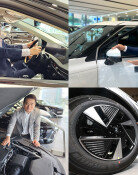Public Transportation That Became Public Suffering
Public Transportation That Became Public Suffering
Posted July. 01, 2004 22:23,
On July 1, the first day of the reform of Seouls public transportation system, extreme traffic congestion was experienced due to the lack of preparation on the part of the city of Seoul.
The transportation card reader for subways (including national railroads) was not properly functioning, resulting in some riders receiving free rides in the morning. In addition, several of the buses covering wide locations, and village buses that were excluded from the one-day free ride of local buses, did not receive fares due to an error in the card reader.
Furthermore, citizens experienced great chaos as the number of local buses was completely changed, and in certain downtown locations, including the area near central busway in Seoul, serious traffic jams occurred.
One traffic expert pointed out that even though it is a large-scale project that unifies the fare system of buses and subways, there has not been sufficient preliminary inspection and added, The problem lies in trying to make the unreasonable deadline of the initiation of the public transportation reform.
--Free-Ride Confusion on Subways
In 140 out of a total 392 subway stations in Seoul and the metropolitan areas during rush hour this day, a situation that called for free fares had to be ordered as card readers were not working.
Company employee Kim Chul-seung (38. Yeonsu-gu, Incheon) stated, I dont feel bad since Im riding free, but it worries me to think about future trials and errors since there were problems with the card readers even on the first day.
Concerning this matter, Koreas Smart Card, the company that operates the new transportation card system, explained that the problems stemmed from a temporary communication impediment and the overload during the process of sending data related to the new fare system to the card reader.
Director Shin Hyung-shik of Smart Card confirmed that, For five hours starting from 5 a.m. on July 1, there was a malfunction of the transportation card reader; however, around 11 a.m., most of the system were restored.
Citizens had already experienced great inconvenience on June 28 as the subways in Seoul had problems with the transportation card reader along the entirety of the 1-4 lines.
--The Buses are Confusing
Citizens who took the bus to go to work appeared to be moving in utter confusion as they did not know the changed routes or were unable to find bus stops. At bus stops, scenes were spotted where people yelled at bus drivers for arriving late after they had been jumping up and down in anxiety.
Company employee Park Gwang-shik (45. Hwajung-dong, Goyang-shi, Gyeonggii) stated, Usually it takes me 30 minutes leaving from Hwajung-dong at 9 a.m.; however, it took me an hour and a half to reach Susek and added, Shouldnt local line buses use central busway as in Seoul?
Company employee Kim Suk-chul (44. Kangnam-gu, Seoul) also criticized the new system by saying, The bus that usually came once every 10 minutes arrived 30 minutes late, making me late for work, and added, What is the necessity of arranging a bus-only road if the interval between the allocation of buses is going to be long?
Company employee Gwak Mi-young (29. Banpo-dong, Seocho-gu, Seoul) pointed out, It took me more than double the time than usual as the number 43 bus route (Jangji-dong~ Gwanghwamoon) that directly took me to Gwanghwamoon from the bus station in front of my house was changed, making me take the green bus in front of my house, then go to the Express Bus Terminal and transfer to a blue bus.
However, areas with central busway in Seoul, including Gangnam Road and Miaroh, received good evaluations that the speed of the bus was extremely quicker than usual.
--Traffic Congestion Resulting From Lack of Preparation
There were congestion in several parts in the downtown area and traffic jams were serious, particularly in areas where the central busway in Seoul ended.
In the case of Susaek and Sungsanroh, as the bus-only route ended at the meeting point with overpass and continued with a changed lane, there was a serious bottle-neck phenomenon where cars drove at slow speeds of 5-10 kmph as the cars coming down from the overpass became entangled with buses that tried to enter the central road.
Because of this, in the direction of Sungsan Bridge, buses and cars that came down by taking the overpass experienced serious traffic jams for approximately 30 minutes, where several bus passengers actually got off the bus at overpass and walked down.
Even though helpers were stationed at each bus stop, they were seen as unhelpful in providing concrete information on how to use the bus and calculate fares as they only distributed the changed bus route maps.
--Countermeasures
The city of Seoul announced their plan to quickly restore and improve problems that arose on the first day of the reform, and to lessen the citizens inconveniences.
On the indicated bus routes that received complaints of buses not coming for a long period of time, the city arranged for reserve vehicles and will start a plan to regulate and guide motorcycles and the vehicles making a left turn trying to enter into the bus-only lanes.
The city announced that they are in the process of reviewing a plan to increase the speed of travel by increasing the number of local line buses.
An aide to Seoul transportation policy, Eum Sung-jik, stated, Since it was the first day of operation, many citizens must have experienced a great deal of inconvenience, and added, As time is needed for the transportation system reform to start showing effects, we need cooperation on the part of citizens as well.
Tae-Hun Hwang Jun-Ho Cha beetlez@donga.com run-juno@donga.com







